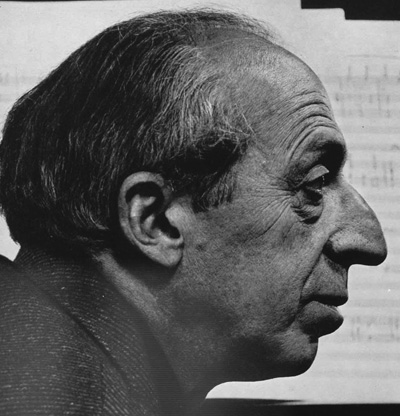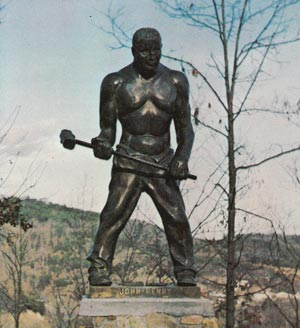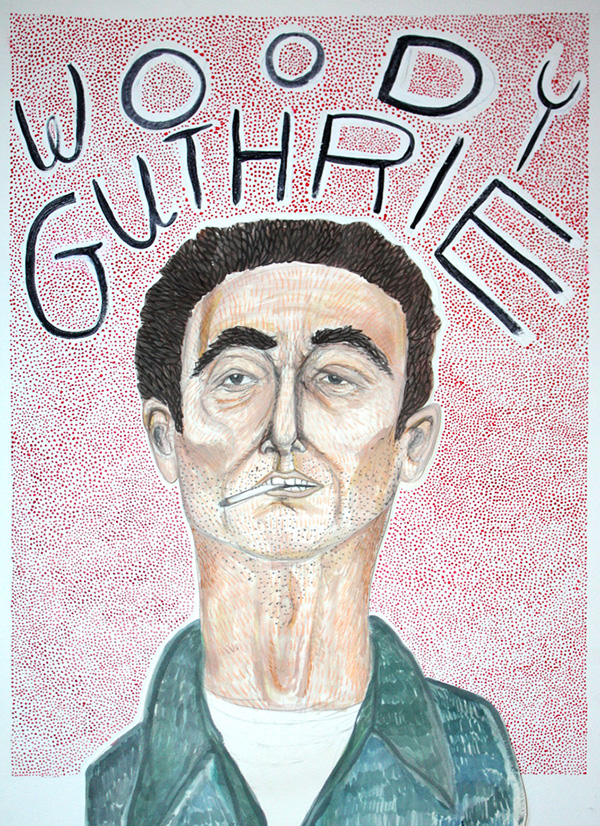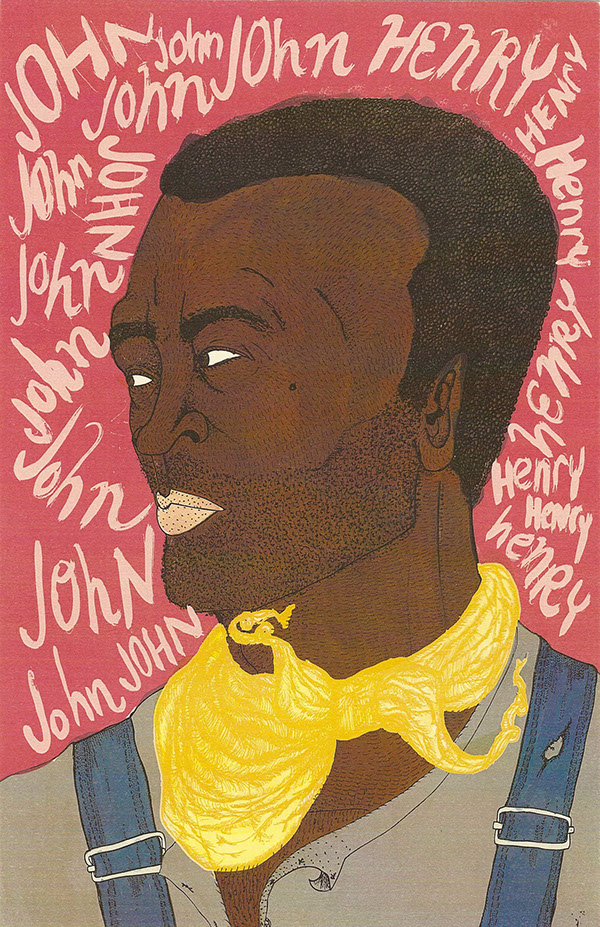"To send light into the darkness of men's hearts
- such is the duty of the artist."
AUTHOR: Robert Schumann
MEANING OF THE QUOTE:
"Art is created to make a better world."

"Art is created to make a better world."
COMPOSER
COPLAND
JOHN HENRY

JOHN HENRY:
A RAILROAD BALLAD
FOR ORCHESTRA
FOR ORCHESTRA
http://www.youtube.com/watch?v=Rd3_S_Tf0p4&feature=related


 |
| Palmer Hayden (American artist, 1890-1973): John Henry and the Steam Drill, 1944 |
Originally intended for radio broadcast on CBS'
"School of the Air," John Henry was revised for
high school orchestras. It is a programmatic
piece about the American folk legend, a 19th
Century black man, and his heroic battle in a
contest against a railroad pile-driver.
Copland wrote,
"Knowing my audience was to be a young one,
and that young people like their music exciting
and not too long, I kept John Henry down to less
than four minutes and called it 'a descriptive fantasy.'"
The music is meant to simulate the sounds of a
train and John Henry's hammer.
Vivian Perlis, 1998:
He worked from six 'till five,
"Raise 'em up bullies and let 'em drop down,
I'll beat you to the bottom or die."
John Henry said to his captain:
"You are nothing but a common man,
Before that steam drill shall beat me down,
I'll die with my hammer in my hand."
"You are nothing but a common man,
Before that steam drill shall beat me down,
I'll die with my hammer in my hand."
John Henry said to the Shakers:
"You must listen to my call,
Before that steam drill shall beat me down,
I'll jar these mountains till they fall."
"You must listen to my call,
Before that steam drill shall beat me down,
I'll jar these mountains till they fall."
John Henry's captain said to him:
"I believe these mountains are caving in."
John Henry said to his captain: "Oh, Lord!"
"That's my hammer you hear in the wind."
"I believe these mountains are caving in."
John Henry said to his captain: "Oh, Lord!"
"That's my hammer you hear in the wind."
John Henry he said to his captain:
"Your money is getting mighty slim,
When I hammer through this old mountain,
Oh Captain will you walk in?"
"Your money is getting mighty slim,
When I hammer through this old mountain,
Oh Captain will you walk in?"
John Henry's captain came to him
With fifty dollars in his hand,
He laid his hand on his shoulder and said:
"This belongs to a steel driving man."
He laid his hand on his shoulder and said:
"This belongs to a steel driving man."
John Henry was hammering on the right side,
The big steam drill on the left,
Before that steam drill could beat him down,
He hammered his fool self to death.
The big steam drill on the left,
Before that steam drill could beat him down,
He hammered his fool self to death.
They carried John Henry to the mountains,
From his shoulder his hammer would ring,
She caught on fire by a little blue blaze
She caught on fire by a little blue blaze
I believe these old mountains are caving in.
John Henry was lying on his death bed,
He turned over on his side,
And these were the last words John Henry said
"Bring me a cool drink of water before I die."
And these were the last words John Henry said
"Bring me a cool drink of water before I die."
John Henry had a little woman,
Her name was Pollie Ann,
He hugged and kissed her just before he died,
Saying, "Pollie, do the very best you can."
Her name was Pollie Ann,
He hugged and kissed her just before he died,
Saying, "Pollie, do the very best you can."
John Henry's woman heard he was dead,
She could not rest on her bed,
She got up at midnight, caught that No. 4 train,
"I am going where John Henry fell dead."
She could not rest on her bed,
She got up at midnight, caught that No. 4 train,
"I am going where John Henry fell dead."
They carried John Henry to that new burying ground
His wife all dressed in blue,
She laid her hand on John Henry's cold face,
"John Henry I've been true to you."
LINKS

SOME "JOHN HENRY"
LESSON PLANS
http://te401social.wikispaces.com/John+Henry+Lesson+Plans
http://bluegrassfoundation.org/wp-content/uploads/2012/03/PerspectivesOnALegend.doc
http://www.npr.org/ramfiles/me/20020902.me.johnhenry.john.ram
http://www.brighthubeducation.com/middle-school-history-lessons/127845-john-henry-steel-driving-man/
http://www.library.pitt.edu/voicesacrosstime/LessonPlans/documents/JohnHenryBlues.pdf
http://www.bluegrasslyrics.com/print/node/31
http://www.stclair.k12.il.us/ccore/English/documents/Grade%202/Grade%202%20Listening%20and%20
Learning%20Domain%201%20Anthology%20Fairy%20Tales%20and%20Tall%20Tales.pdf
http://www-tc.pbs.org/theblues/classroom/downloads/oral_tradition_the_blues.pdf
http://www.shmoop.com/woody-guthrie-john-henry/
http://www.warrensymphony.com/wp-content/uploads/2013/02/John_Henry.Lesson.Plan_.pdf
THE LEGEND OF JOHN HENRY
construction in the decades following the Civil War. The legend, therefore,
draws in part from the history of America’s railroads. The first real chapter
in this history was written during the 1860's when Congress authorized the
construction of a federally subsidized transcontinental railroad. But another
important chapter was written in the South following the Civil War. During
Reconstruction, progressive Southerners resolved to modernize their
economy and become full partners within the national market by building
railroads.
Many of the laborers on these railroads were white. Often dissatisfied with
the pace and pay of railroad work, they participated in the major labor
struggles of the late nineteenth century. The strikes on the railroads were
among the most violent in American history; in 1877 and 1894, these
strikes caused massive property damages and led to many deaths. Generally,
the workers lost, but they learned valuable lessons in labor organization.
And the severity of the strikes led middle-class reformers to promote federal
legislation that would protect the rights of workers during the Progressive Era.
White labor organizers weren't the only ones working on the railroad all the
livelong day, though. Recently freed slaves also found work on the Southern
railroads. The work was backbreaking, but for many it was preferable to the
most common alternative: sharecropping. Most former slaves found work
initially on the very land that they had worked as slaves. While technically
free, they often found themselves stuck within a cycle of debt that was could
be as demoralizing as slavery. It’s possible that the real John Henry was a
former slave looking to break that cycle by showing how hard he could drive
that steel.
His wife all dressed in blue,
She laid her hand on John Henry's cold face,
"John Henry I've been true to you."
 |
| Palmer Hayden |
.jpg) |
| http://www2.ferrum.edu/applit/studyg/west/htm/henry.htm |
STORY FROM AMERICAN FOLKLORE:
John Henry: The Steel Driving Man
A West Virginia Legend retold by S.E. Schlosser
Now John Henry was a mighty man, yes
sir. He was born a slave in the 1840's
but was freed after the war. He went to
work as a steel-driver for the Chesapeake
& Ohio Railroad, don't ya know. And
John Henry was the strongest, the most
powerful man working the rails.
John Henry, he would spend his day's
drilling holes by hitting thick steel spikes
into rocks with his faithful shaker
crouching close to the hole, turning
the drill after each mighty blow. There
was no one who could match him,
though many tried.
Well, the new railroad was moving along
right quick, thanks in no little part to the
mighty John Henry. But looming right
smack in its path was a mighty enemy-
the Big Bend Mountain. Now the big
bosses at the C&O Railroad decided that
they couldn't go around the mile and a
quarter thick mountain. No sir, the men
of the C&O were going to go through it-
drilling right into the heart of the mountain.
A thousand men would lose their lives
before the great enemy was conquered.
It took three long years, and before it was
done the ground outside the mountain was
filled with makeshift, sandy graves. The
new tunnels were filled with smoke and
dust. Ya couldn't see no-how and could
hardly breathe. But John Henry, he worked
tirelessly, drilling with a 14-pound hammer,
and going 10 to 12 feet in one workday.
No one else could match him.
Then one day a salesman came along to
the camp. He had a steam-powered drill
and claimed it could out-drill any man.
Well, they set up a contest then and there
between John Henry and that there drill.
The foreman ran that newfangled steam-
drill. John Henry, he just pulled out two 20-
pound hammers, one in each hand. They
drilled and drilled, dust rising everywhere.
The men were howling and cheering. At
the end of 35 minutes, John Henry had
drilled two seven foot holes - a total of
fourteen feet, while the steam drill had
only drilled one nine-foot hole.
John Henry held up his hammers in
triumph! The men shouted and cheered.
The noise was so loud, it took a moment
for the men to realize that John Henry
was tottering. Exhausted, the mighty man
crashed to the ground, the hammer's
rolling from his grasp. The crowd went
silent as the foreman rushed to his side.
But it was too late. A blood vessel had
burst in his brain. The greatest driller
in the C&O Railroad was dead.
Some folks say that John Henry's
likeness is carved right into the rock
inside the Big Bend Tunnel. And if you
walk to the edge of the blackness of the
tunnel, sometimes you can hear the
sound of two 20-pound hammers drilling
their way to victory over the machine.
SOME "JOHN HENRY"
LESSON PLANS
http://te401social.wikispaces.com/John+Henry+Lesson+Plans
http://bluegrassfoundation.org/wp-content/uploads/2012/03/PerspectivesOnALegend.doc
http://www.npr.org/ramfiles/me/20020902.me.johnhenry.john.ram
http://www.brighthubeducation.com/middle-school-history-lessons/127845-john-henry-steel-driving-man/
http://www.library.pitt.edu/voicesacrosstime/LessonPlans/documents/JohnHenryBlues.pdf
http://www.bluegrasslyrics.com/print/node/31
http://www.stclair.k12.il.us/ccore/English/documents/Grade%202/Grade%202%20Listening%20and%20
Learning%20Domain%201%20Anthology%20Fairy%20Tales%20and%20Tall%20Tales.pdf
http://www-tc.pbs.org/theblues/classroom/downloads/oral_tradition_the_blues.pdf
http://www.shmoop.com/woody-guthrie-john-henry/
http://www.warrensymphony.com/wp-content/uploads/2013/02/John_Henry.Lesson.Plan_.pdf
THE LEGEND OF JOHN HENRY
Retold by Disney
Introduction
Paul Bunyan, Pecos Bill, and John Henry are legendary figures with larger
than life exploits but there is one big difference between them: John Henry
may have been real. There’s plenty of evidence to suggest that the steel-
driving railroad man actually lived and that he did die in a triumphant race
against a machine.
Unfortunately, the details are a bit sketchy. Some say Henry was a former
than life exploits but there is one big difference between them: John Henry
may have been real. There’s plenty of evidence to suggest that the steel-
driving railroad man actually lived and that he did die in a triumphant race
against a machine.
Unfortunately, the details are a bit sketchy. Some say Henry was a former
slave; others say he was a free black from New Jersey (we can’t imagine why
he left). Some believe he raced a steam drill in Virginia; others argue that the
contest occurred in Alabama. Some place the events in 1870; others argue
that the race occurred during the 1880's.
So what’s the truth? If John Henry was real, exactly who was he, and where
and when did he take on a machine? And whether real or fictitious, why would
people care enough to turn his deadly contest into a song?
Connections
Explore the ways this song connects with the world.
The legend of John Henry emerge during the heyday of Southern railroad
The legend of John Henry emerge during the heyday of Southern railroad
draws in part from the history of America’s railroads. The first real chapter
in this history was written during the 1860's when Congress authorized the
construction of a federally subsidized transcontinental railroad. But another
important chapter was written in the South following the Civil War. During
Reconstruction, progressive Southerners resolved to modernize their
economy and become full partners within the national market by building
railroads.
Many of the laborers on these railroads were white. Often dissatisfied with
the pace and pay of railroad work, they participated in the major labor
struggles of the late nineteenth century. The strikes on the railroads were
among the most violent in American history; in 1877 and 1894, these
strikes caused massive property damages and led to many deaths. Generally,
the workers lost, but they learned valuable lessons in labor organization.
And the severity of the strikes led middle-class reformers to promote federal
legislation that would protect the rights of workers during the Progressive Era.
White labor organizers weren't the only ones working on the railroad all the
livelong day, though. Recently freed slaves also found work on the Southern
railroads. The work was backbreaking, but for many it was preferable to the
most common alternative: sharecropping. Most former slaves found work
initially on the very land that they had worked as slaves. While technically
free, they often found themselves stuck within a cycle of debt that was could
be as demoralizing as slavery. It’s possible that the real John Henry was a
former slave looking to break that cycle by showing how hard he could drive
that steel.
To read more of this article go to:






